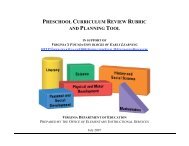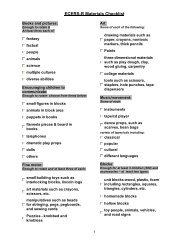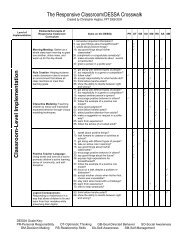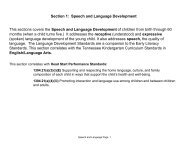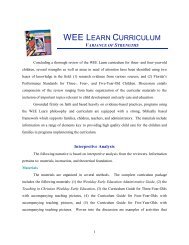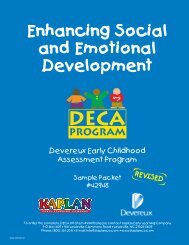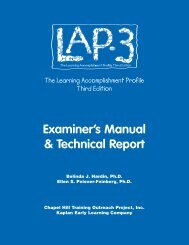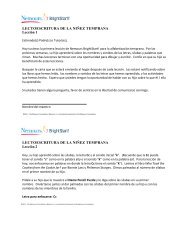Examiner's Manual & Technical Report - Kaplanco.com
Examiner's Manual & Technical Report - Kaplanco.com
Examiner's Manual & Technical Report - Kaplanco.com
- No tags were found...
You also want an ePaper? Increase the reach of your titles
YUMPU automatically turns print PDFs into web optimized ePapers that Google loves.
White 281 48 141 069 0539 047.9Other 1 018 04 053 034 0109 009.7Total 354 91 330 349 1124 100.01 Children classified as “Other” were reported according to the following distribution: “other” n=22 (1.96%); “two or more races/ethnicities” n=66 (5.87%);“unknown” n=17 (1.51%).2 The 2000 US Census Bureau population estimates were: African American=12.3%; American Indian and Alaskan Native=0.9%; Asian, Native Hawaiian,and Pacific Islander=3.7%; White=75.1%; Other=7.9%. In addition, the US Census 2000 population estimates include 12.5% Hispanic/Latino in the generalpopulation.To represent the variety of cultural and ethnic groups within the Latino population of the UnitedStates, Spanish-speaking children were proportionally selected for the sample to reflect the majorcultural backgrounds groups indicated in the 2000 U.S. Census (2000, 2001). These groupsincluded the following categories: Central and South American, Cuban, Mexican, Puerto Rican,and “other” Hispanic. For the purposes of this research, the mother’s country of origin was usedto determine cultural background. If the mother’s country of origin was not available, the father’scountry of origin was used. Table 5b depicts the cultural background distribution by geographicregion for Spanish-speaking children.Table 5b. Spanish-Speaking Sample by Cultural Background and Geographic Region (n=975)Central Northeast South Southwest Total 2Cultural Background n n n n N %Central and South American 031 00 109 007 147 015.1Cuban 000 00 028 000 028 002.9Mexican 181 00 070 169 420 043.1Puerto Rico 000 03 010 001 014 001.4Other 1 105 10 135 116 366 037.5Total 317 13 352 293 975 100.01 Cultural backgrounds classified as “Other” were reported according to the following distribution: “not reported” n=330 (32.8%); “Dominican Republic” n=10(1.0%); “Other” n=26 (2.67%).2 The 2000 US Census Bureau population estimates were: Central and South American=8.6%, Cuban=3.5%, Mexican=58.5%, Puerto Rican=9.6%, OtherHispanic=19.8%.Family CharacteristicsParents were asked questions about family characteristics, including family <strong>com</strong>position,parental educational levels, in<strong>com</strong>e level, and home languages. Table 6 depicts the distribution ofthe number of adults and children in the home for each language group and the project sample.These results suggest that children in the Spanish-speaking sample tended to live in homes withslightly larger numbers of adults and children.47




